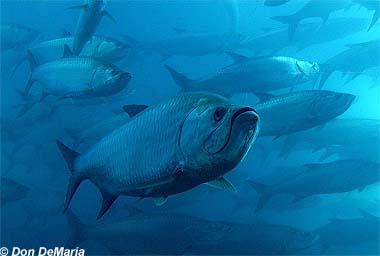
Megalops atlanticus
These long fish have slightly upturned faces and soft, lobed fins, and they can grow to more than 8 feet long and over 350 pounds. From above they appear dark blue or greenish black, or even brassy if they’ve been in inland waters, but they are recognizable for their very shiny silver sides covered in large scales. They live in bays and mangrove lagoons, and can travel up rivers into freshwater. As well, they can, and usually need to, gulp air as a way to get additional oxygen. Tarpon are prized for their fight but not their flesh by sport fishers, but they are protected by significant regulations.
Order – Elopiformes
Family – Megalopidae (Elopidae)
Genus – Megalops
Species – atlanticus
Common Names
The silver king is the most common pseudonym given to the tarpon by anglers, descriptive of the bright flash that reflects from its large silver scales when it jumps into the air. Other common names include abalitsa, Atlantic tarpon, atlantischer tarpun, bass, big scale, caffum, camurupi, grande ecaille, grand-écaille, grande ecoy, jewfish, madzorfloe, manyofle, mell, ofin, palika, peixe-prata, peixe-prata-do-atlântico, pez lagarto, sabalo, sábalo, sabaloreal, sabilo real, sadina, savalle, savallo, savaloreal, savanilla, silberfisch, silverfish, suwiki, tainha, tainha-congo, tapam, tarpao, tarpão, tarpão-do-Atlântico, tarpoen, tarpom, tarpón, tarpon argenté, tarpon atlantycki, tarpon trapoen, tarpone tarpone, tarponi, tarpum, trapoen, and wallidöër.
Importance to Humans
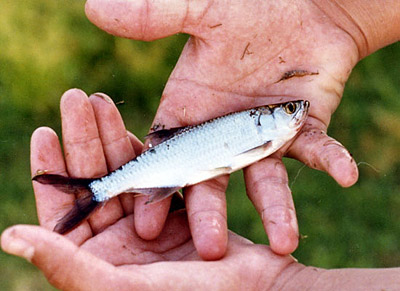
In Florida, the commercial sale of tarpon is prohibited. Recreationally, the tarpon provides a huge industry for charter captains. In the Florida Keys, many of these guides make the bulk of their earnings from April through June, the prime months for tarpon migrations. Recreational anglers must obtain a tarpon tag (purchased prior to catching) in order to possess a tarpon. However, most tarpon guides and anglers esteem the tarpon and nearly always release the fish unharmed. Most mortality attributed to human activity occurs from injuries incurred when being landed, such as “gut hooking” or sharks that take advantage of the hooked fish. Though conscientious anglers attempt to break the line to release the tarpon from restraint, sharks occasionally leave the angler with only half of the fish. Although this is considered an important game fish, the flesh is not highly prized in the United States, though the natives of Panama, the West Indies, and Africa consider the tarpon a delicacy and sell it on a small scale.
Danger to Humans
Though tarpon usually spook easily and show extreme wariness when around humans, they occasionally, and usually accidentally, injure humans. Most injuries occur when anglers try to release tarpon after a fight, whereby tarpon have reportedly killed the angler in its violent thrashing. To avoid this situation, one should not attempt to boat a tarpon that is still green (i.e., full of vigor). Let the fish thoroughly tire out before attempting to either gaff or bring the tarpon close for release. Occasionally a tarpon will rush toward and inadvertently leap into the boat. Several tarpon guides have reported having such a fish destroy rods, electronics, and other equipment.
Conservation Status
Although tarpon may not be harvested commercially, debate looms over the recovery of fish caught and released. Though released, a tired tarpon that is not adequately resuscitated may die from oxygen deprivation or may more easily fall prey to predators such as sharks. In order to assess the hook-and-release survival of tarpon, the Florida Marine Research Institute is in the process of designing a study in order to track released individuals and determine their rate of post-release survival.
While any angler may practice catch-and-release in pursuing tarpon, beginning in 1989 anglers must obtain a tarpon tag in order to possess and deliberately kill them. The permit costs $50 for each tarpon (limit two per day), and the anglers who purchase the tag agree to provide the Florida Marine Research Institute with information about the catch, including date and location of capture, the length and weight of the fish, and how many anglers were fishing. According to data obtained since this permit was instituted, the number of tarpon killed has steadily dropped from 342 in 1989 to 70 in 1998.
> Check the status of the tarpon at the IUCN website.
The IUCN is a global union of states, governmental agencies, and non-governmental organizations in a partnership that assesses the conservation status of species.
Geographical Distribution
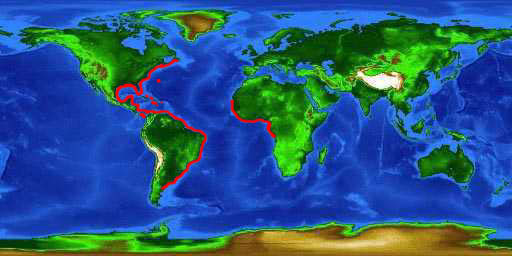
Tarpon inhabit a large range on both sides of the Atlantic Ocean. The range in the Eastern Atlantic extends from Senegal to the Congo. In the Western Atlantic, the fish primarily inhabit warmer coastal waters concentrating around the Gulf of Mexico, Florida, and the West Indies. However, tarpon are not uncommon as far north as Cape Hatteras, and the extreme range extends from Nova Scotia in the north, Bermuda, and to Argentina to the south. Tarpon have been found at the Pacific terminus of the Panama Canal and around Coiba Island.
Habitat
Tarpon populate a wide variety of habitats, but are primarily found in coastal waters, bays, estuaries, and mangrove-lined lagoons within tropical, subtropical, and temperate climates (45° N-30° S). The normal habitat depth extends to 98 feet (30 m). Although a marine fish, tarpon can tolerate euryhaline environments (0-47 parts per thousand) and often enter river mouths and bays and travel upstream into fresh water. In addition, tarpon can also tolerate oxygen-poor environments due to a modified air bladder that allows them to inhale atmospheric oxygen. The only variable that seems to limit their choice of habitat is temperature, and research shows tarpon to be thermophilic. Rapid decreases in temperature have been known to cause large tarpon kills. During such temperature drops, tarpon usually take refuge in warmer deeper waters.
Biology
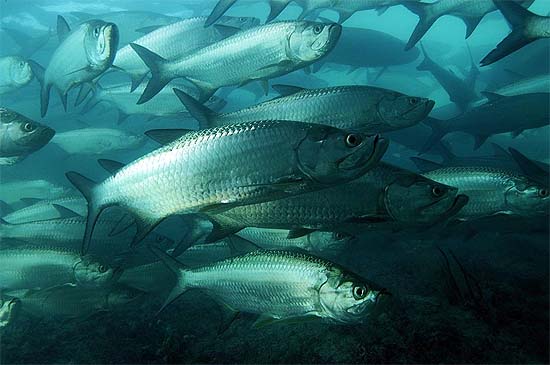
Distinctive Features
Externally, the almost vertical, silvery sides made up of large scales are the most distinctive feature of the tarpon. The tarpon has a superior mouth with the lower mandible extending far beyond the gape. The fins contain no spines, but are all composed of softrays. The dorsal fin appears high anteriorly and contains 13-15 softrays with the last ray greatly elongated into a heavy filament. The caudal is deeply forked, and the lobes appear equal in length. The anterior portion of the anal fin is deep and triangular. The fin has 22-25 softrays, with the last ray again elongated as in the dorsal fin, but shorter and only present in adults. The tarpon has large pelvic fins, and long pectoral fins containing 13-14 softrays.
Perhaps the most unique internal feature of the tarpon is the modified swim bladder. This swim bladder contains spongy alveolar tissue and has a duct leading to the esophagus that the tarpon may fill directly with air gulped from the surface. This feature allows the tarpon to take oxygen directly from the atmosphere and increases its tolerance of oxygen-poor waters. In fact, studies have shown that tarpon must have access to atmospheric oxygen in order to survive, and that juvenile tarpon are obligatory air-breathers. Adults living in oxygen-rich waters still roll and gulp air, probably as an imitative pattern based on visual perception of other tarpon.
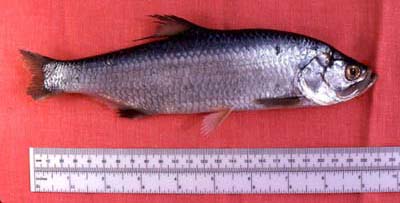
Coloration
The synonym “silver king” refers to the predominant bright silver color along the sides and belly of the tarpon. Dorsally, tarpon usually appear dark blue to greenish-black. However, the color may appear brownish or brassy for individuals inhabiting inland waters. The dorsal and caudal fins have dusky margins and often appear dark.
Dentition
Despite having an enormous mouth, often exaggerated by anglers or others as being the size of a five-gallon bucket, tarpon have extremely small villiform (i.e., fine densely packed) teeth on their jaws, vomer, palatines, pterygoids, tongue, and skull base. In addition, tarpon have an elongated bony plate along the long, upturned lower jaw. The tarpon uses this plate to crush crustaceans and other prey not consumed whole.
Size, Age & Growth
Female tarpon can grow to lengths of over 8.2 feet (2.5m) and reach weights of near 355 pounds (161 kg), with the males generally smaller. Tarpon are slow-growing fish and do not obtain sexual maturity until reaching an age of 6-7 years and a length of about 4 feet (1.2 m). Tarpon weighing about 100 pounds (45.4 kg) typically fall between 13-16 years of age. Male tarpon attain lifespans of over 30 years, while females may live longer than 50 years. A female tarpon held in captivity at the John G. Shedd Aquarium in Chicago, Illinois died in 1998 at the age of 63.
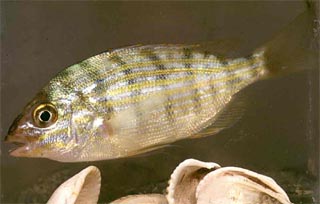
Food Habits
The tarpon employs different feeding techniques depending upon its level of growth and development. Stage I larvae absorb nutrients directly from seawater through the integument. Zooplankton (copepods and ostracods), insects, and small fish compose the diet of stage II and III tarpon larvae and small juveniles. As tarpon grow, they move away from zooplankton as a chief food source and prey more exclusively on fishes (especially poecilids and cyprinodontids) and larger invertebrates such as shrimp and crabs. While juvenile tarpon are planktivorous, adult tarpon are strictly carnivorous and mostly feed on mid-water prey such as mullets, pinfish, marine catfishes, Atlantic needlefish, sardines, shrimp, and crabs. Tarpon feed during both day and night. Since the tarpon have minute teeth only, they usually swallow the prey whole.
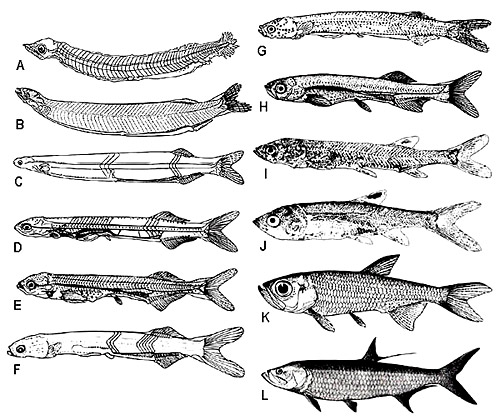
Reproduction
The sexual fecundity of a 6.6 foot (2 m) tarpon is about 12 million eggs. The fish typically spawn in May, June, and July, though evidence exists that suggests they spawn year-round. They make extensive migrations to offshore spawning areas where currents then move the larvae to inshore nurseries. Tarpon reach sexual maturity at 6-7 years of age and a length of about 4 feet (1.2 m).
Tarpon possess a leptocephalus larval stage, a reproductive strategy seen elsewhere only amongst the closely related bonefish (Albulidae), ladyfish (Elopidae), and true eels (Anguilliformes). The transformation from the transparent, ribbon-like leptocephalus to juvenile tarpon occurs in three distinct stages. Stage 1 leptocephali grow to a length of 6-28 mm and last from 2-3 months. Instead of continuing growth in stage 2, the larvae shrink to about 14 mm. This stage lasts 20-25 days. The larvae grow again in stage 3 and become juveniles at a length of approximately 40 mm, this final stage lasting about 7-8 weeks.
Zooplankton and small fishes prey on tarpon in the egg and larval stages, and piscivorous birds are primary predators of juvenile tarpon once they enter nursery areas. Sharks, e.g. bull and hammerhead, are the main predators of adult tarpon, but porpoises and alligator also prey on the fish.
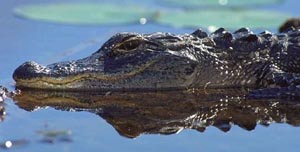
Parasites
The most common internal parasite found in the tarpon is the digenetic trematode Lecithochirium microstomum, which occurs in the stomach of tarpon. The trematode Bivescula tarponis occurs in the pyloric caecae and throughout the entire length of the intestine. External parasites include the isopods Nerocila acuminata,Cymothoa oestrum and the copepod Paralebion pearsei. Though not parasitic, remoras (Remora remora) often attach to large tarpon.
Taxonomy
Valenciennes described the tarpon in 1847, classifying it under the genus Megalops, which translates from the Greek into “large-eyed,” a conspicuous feature of the tarpon. While most agree on the fish’s placement in the order Elopiformes, scientists debate whether its family designation should fall within the family Elopidae or the family Megalopidae, a family separate from Elopidae within the suborder Elopoidei. One other species exists in the genus,Megalops cyprinoides, the ox-eye. Synonyms of Megalops atlanticus appearing in the literature include Clupea gigantea, Megalops giganteus, Megalops atlantica (misspelling), Tarpon atlanticus, and Megalops elongatus.
Prepared by: Sean Morey